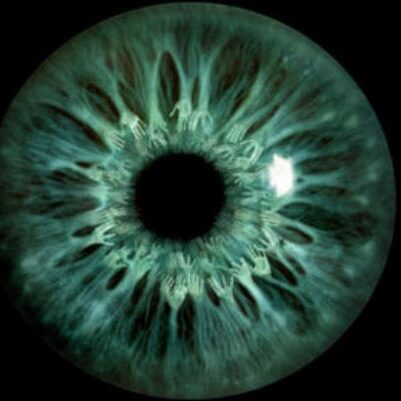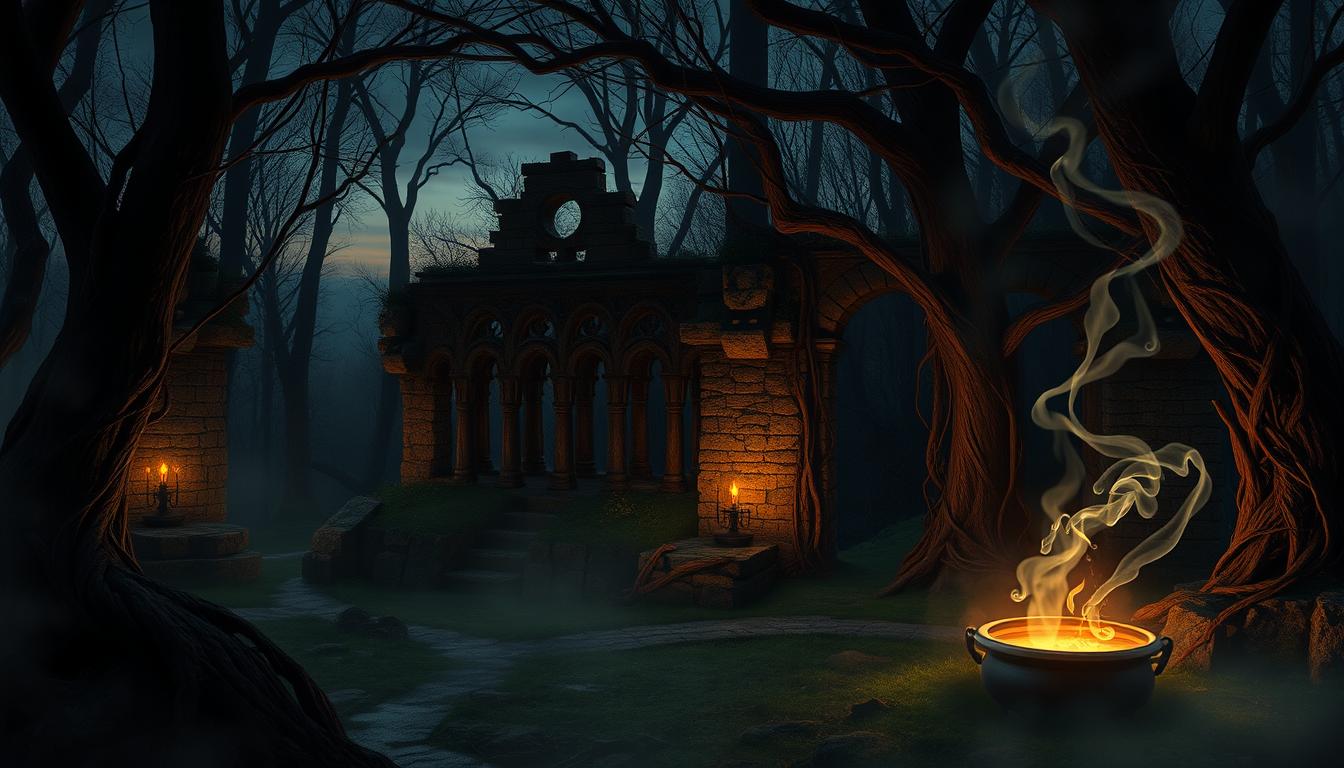Once upon a time, in a quaint village, a whisper spread fast. It was about a mysterious woman living alone in the woods. She was said to talk to nature and the unseen forces. The villagers, full of superstition and fear, called her a “witch.”
This set the stage for a tale that would last through the ages. The history of witches is full of ancient beliefs, cultural traditions, and changing human views on the supernatural. From ancient times to today, witchcraft has caught our imagination and changed history.
Key Takeaways
- Belief in witches goes back before Christianity, to ancient Greece and Rome.
- Over time, witches have been seen differently by various cultures and religions.
- In the medieval and early modern times, many people, mostly women, were killed for being accused of witchcraft.
- Witchcraft is found in cultures all over the world, with many different beliefs and practices.
- Today, a new generation is embracing witchcraft, with many practicing different forms of it.
The Origin of Witches
The story of witchcraft goes way back to ancient times. People with magical powers were often seen as powerful or feared. From the early witches to the biblical views on witchcraft, their history is a big part of our past.
Early Beliefs and Practices
In Europe, witchcraft got linked to the devil during the Middle Ages. This was because Christianity spread and saw pagan ways as wrong. But, the idea of witchcraft was around long before Christianity. Ancient places like China, Mesopotamia, Rome, Egypt, and Greece talked about people with magical powers.
These early witches were seen as wise or scary. They could use nature’s forces for their goals. The idea of witchcraft linked to the spiritual and natural worlds. Witches were thought to control the world around them.
Biblical References to Witchcraft
The idea of witchcraft also comes from the Bible. It talks about people doing magic and divination. The Bible’s warnings against these things helped link witchcraft with evil. This set the stage for the witch hunts that would happen later in Europe.
As Christianity spread, people saw witches as the devil’s helpers. This led to many being wrongly accused and persecuted. This dark history has made witches a big part of our stories and beliefs.
Witch Hunts and the “Malleus Maleficarum”
The Protestant Reformation started in 1517 and changed how people saw witches in Europe. It made religious tensions and fears about the supernatural worse. Protestant leaders saw witchcraft as a form of sorcery linked to Satan. They believed witches made deals with the devil and used magic to hurt others.
This view led to more witch hunts and trials in Protestant areas.
The “Malleus Maleficarum,” or “The Hammer of Witches,” was a key book on witchcraft. Heinrich Kramer wrote it in 1486. It became popular during the Reformation and helped guide how to find and deal with witches.
This book said most witches were women. It claimed they were more likely to be tempted by the devil because of Eve’s sin.
“The Malleus Maleficarum was a misogynistic text that influenced the view that witches were predominantly female.”
By the 15th century, many Europeans believed in witches. This led to more witch trials and punishments.
Between the 15th and 18th centuries, 40,000 to 60,000 people were sentenced to death for witchcraft in Europe and America. The belief in witches’ powers to harm people started to fade during the Age of Enlightenment. This led to the end of witch trials in Europe around 1780.
The Salem Witch Trials
The Salem witch trials were a dark time in American history. They happened in Salem, Massachusetts, in the late 1600s. During this period, a wave of accusations led to the execution of 20 people accused of witchcraft.
Mass Hysteria and Accusations
In 1692, a group of young girls said they were being possessed by witches. This led to a hunt for those practicing magic. Over 200 people were accused, and many were put on trial.
The trials were unfair. They accepted spectral evidence and hearsay as proof of guilt. This led to many wrongful convictions.
- The Salem witch trials took place between early 1692 and mid-1693.
- More than 200 people were accused, and 20 were executed.
- The trials started with the bewitchment of two girls, Elizabeth Parris and Abigail Williams.
- A special Court of Oyer and Terminer was set up for the witchcraft cases.
Aftermath and Legacy
The Salem witch trials left a lasting impact. In 1697, the Massachusetts General Court declared the trials unlawful. In 1711, financial help was given to the families of those wrongly accused.
Over 250 years later, in 1957, Massachusetts officially apologized for the Salem witch trials.
“The Salem witch trials serve as a cautionary tale, reminding us of the dangers of prejudice, fear, and the power of hysteria to cloud judgment and lead to the persecution of innocent people.”
Today, the Salem Witch Museum and the Witch Trials Memorial keep the memory of these events alive. They remind us of a dark time in American history.
Witchcraft Around the World
Witchcraft beliefs spread far beyond Western Europe. They took root in many cultures worldwide. From Africa to Asia, and from the Pacific Islands to South America, witchcraft was a big part of traditional life. It was linked to magic and spiritual practices.
Beliefs and Practices Across Cultures
Rituals and traditions around witchcraft beliefs around the world were very different. In Africa, witchcraft was a big part of life. People believed in magic and could talk to spirits.
In America and Scotland, witchcraft was also a big part of local life. Despite these differences, a common idea linked these beliefs. People believed in those with special powers and supernatural abilities.
These beliefs led to many practices. From exorcisms to healing rituals, witchcraft met the needs of different communities. It showed the wide range of beliefs and practices around the world.
| Region | Witchcraft Beliefs and Practices |
|---|---|
| Africa | Witchcraft was big in traditional African societies. It was linked to magic and the spiritual world. Different ethnic groups had their own rituals and beliefs. |
| Asia | In Asia, witchcraft was found in cultures like China, Japan, and India. Each had its own traditions and magical elements. |
| South America | Indigenous people in South America saw witchcraft as part of their beliefs. They used rituals, herbs, and spiritual practices. |
| North America | The Salem Witch Trials showed the wide range of witchcraft beliefs around the world. Native American traditions also highlighted this diversity. |
Witchcraft beliefs were a big part of human life worldwide. They shaped spiritual, social, and political life in many communities.
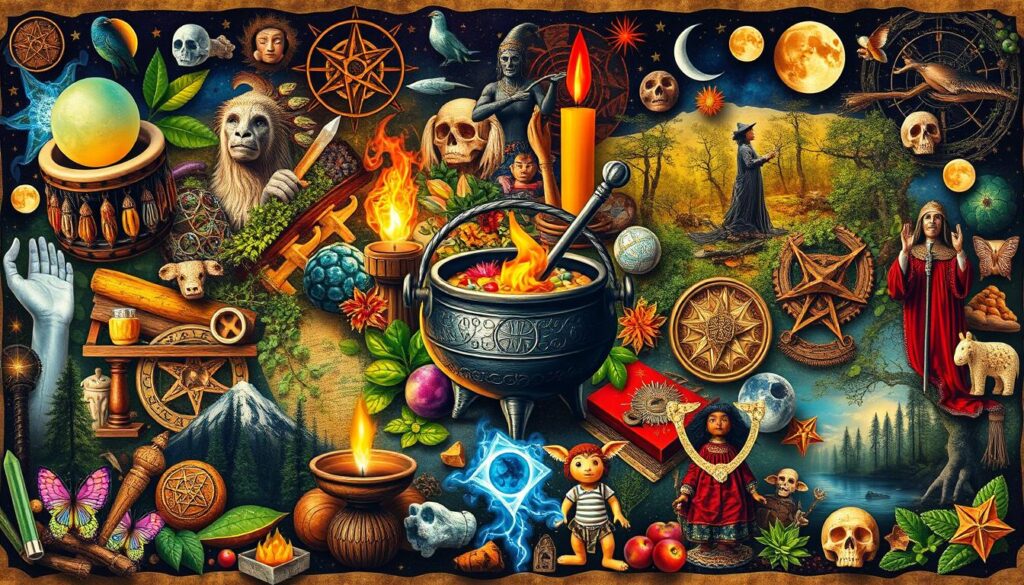
The Protestant Reformation and Witchcraft
The Protestant Reformation started in 1517 with Martin Luther’s “Ninety-Five Theses.” It changed how people saw witches and witchcraft in Europe. The Reformation questioned the Catholic Church’s power, leading to more fear and tension about supernatural practices.
Protestant leaders saw witchcraft as a form of sorcery tied to Satan. They thought witches made deals with the devil and used magic to harm others. This view led to more witch hunts and trials in Protestant areas.
The Protestant clergy helped spread this fear. They gave sermons about the dangers of witchcraft. They also helped identify and punish those seen as practicing sorcery.
The Reformation greatly affected the persecution of witchcraft in Europe. Between 1560 and 1630, 80,000 people were accused of witchcraft, and 40,000 were killed. Germany, where Protestantism spread first, was responsible for 40% of these witchcraft persecutions. Other Protestant countries like Switzerland, France, England, and the Netherlands made up 35%.
Only 6% of the religious persecution of witches happened in strongly Catholic areas like Spain, Italy, Portugal, and Ireland. The end of witch hunts in the late 17th century came with the Peace of Westphalia. This treaty ended religious wars and changed Europe’s balance of power.
“The persecutions of witches were widespread in Western Europe between 1560 and 1630, shortly after the Protestant Reformation began. Many of the Protestant complaints centered around abuses of the Catholic Church and changing theology, including disbelief in good works, access to the Bible, and criticisms of indulgences.”
What is the history of witches?
The history of witches is a long and interesting story. For many years, being a witch was seen as a serious crime. Those accused faced harsh punishments, even death. People believed witches made deals with the devil, gaining evil powers.
During the early modern times, from the 15th to the 18th century, witch trials happened. These trials were caused by many things like religious disagreements, war, strange weather, more people, and high prices. Witches were blamed for many bad things. If someone accused someone of being a witch, panic could spread fast.
About 45,000 people were executed for being witches. Most of them were women. The most intense witch-hunting was from 1550 to 1630 in Europe. This time was filled with harsh trials and executions.
By the 18th century, people stopped seeing witches as a threat. They were seen as old superstitions of peasants. Today, witchcraft’s history has changed a lot. Modern stories and art often don’t match the real history of witchcraft and the hunts.
Now, people are still interested in witchcraft. Young people are exploring witch traditions and practices. This interest is seen on platforms like Witchtok and in movements like Wicca. The story of witches still captures and inspires many.
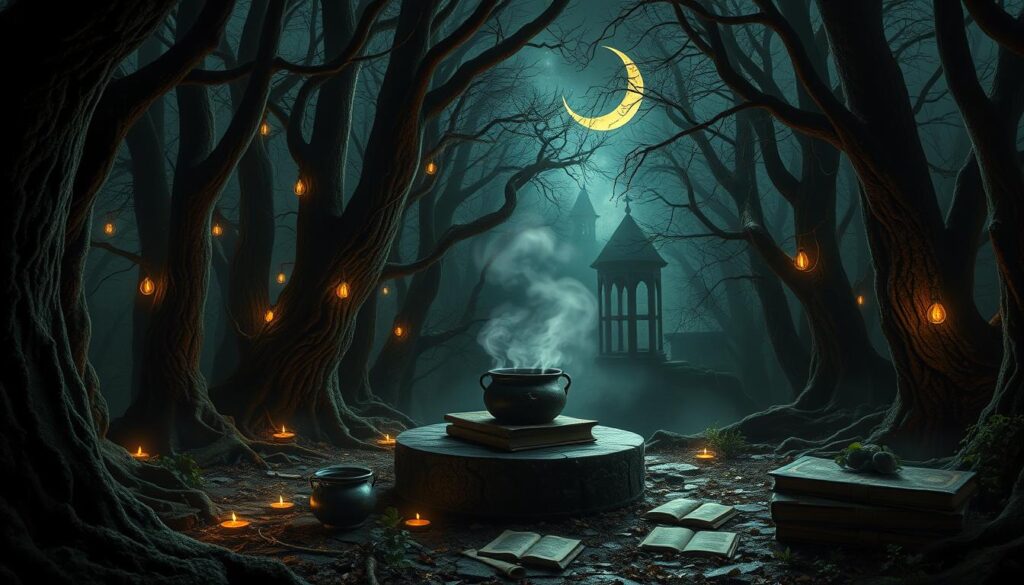
“The history of witches is a complex and intriguing narrative that spans several centuries.”
Witchcraft and the Renaissance
The Renaissance brought big changes to how people saw witchcraft. Scholars and thinkers started to doubt the old beliefs about witches. They looked for new explanations for mysterious events.
Shifting Attitudes and Skepticism
The Renaissance changed how people viewed witchcraft. Before, there were many witch hunts and persecutions. But during the Renaissance, people started to doubt these beliefs.
Smart people and scientists looked for logical reasons behind what was once seen as supernatural. The Protestant Reformation also played a part. It questioned the Catholic Church’s views on witchcraft.
This led to fewer witch hunts over time. More people, especially the educated, doubted the idea of witchcraft. This change helped society understand witches in a new way.
| Statistic | Description |
|---|---|
| Old women were more likely to be tried for witchcraft than young women during the Renaissance. | Cultural beliefs during the Renaissance associated certain traits with witches, such as old age, seclusion, and unpleasant demeanor. |
| Agnes Waterhouse, one of the first women tried and convicted of witchcraft in 1566, dealt with a cat familiar called Satan, implicating her in witchcraft practices. | The presence of familiar spirits associated with witches, such as cats or imps, was used as evidence in witchcraft trials. |
| John Lowes, a clergyman, was tried for witchcraft in 1645, indicating that even men were accused of practicing witchcraft during the Renaissance. | Witchcraft accusations were not limited to women, as the case of John Lowes demonstrates that men were also targeted during this period. |
The Renaissance changed how people saw witchcraft. There was more skepticism and a push for scientific explanations. This led to a deeper understanding of witchcraft in society.
The Evolution of Witchcraft in Popular Culture
Witchcraft has always caught the public’s eye, shaping popular culture. It has moved from literature and art to film and TV, showing how society views this ancient practice. Over time, how witches are shown has changed a lot.
Before, witchcraft was feared and many people, mostly women, were wrongly accused and executed. Now, witches are often shown in a more positive light. This change shows how society’s view of witches has shifted.
The feminist movement has greatly influenced how witches are seen today. It shows witches as powerful and fighting against male dominance. This is clear in “Harry Potter” and “Charmed,” where witches are strong and sometimes heroes.
Witches have moved from being seen as outsiders to being stars of pop culture. This is seen in “The Wizard of Oz” and “Wicked,” where witches are complex characters. These stories have helped change the bad views on witchcraft.
Today, witches are often linked with nature, spirituality, and women’s power. This change has drawn in audiences and changed how people see witchcraft and women’s roles.
“Witchcraft is a powerful symbol of female empowerment and resistance against patriarchal oppression. The evolution of its portrayal in popular culture reflects the changing attitudes and perceptions towards this ancient practice.”
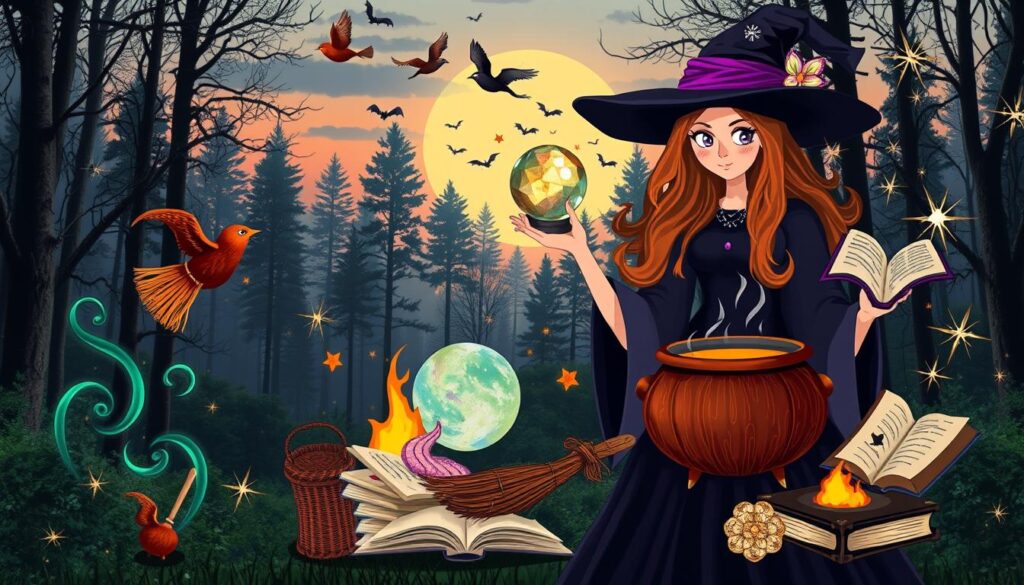
The way witchcraft is shown in popular culture is still changing. It reflects the complex and diverse nature of witchcraft and its lasting impact.
Modern Witchcraft: Wicca and Neopaganism
In the 20th century, modern witchcraft saw a big comeback with Wicca and neopaganism. Wicca is a key part of modern witchcraft today. It’s a pagan religious movement that brings back old practices and beliefs.
The Wiccan Belief System
Wicca is all about respecting nature, worshipping a goddess and god, and practicing witchcraft. They believe in a divine energy that fills the universe. This energy can be used through rituals and spells.
At the heart of Wicca is the idea that everything in the world is connected. It’s crucial to live in tune with nature.
Rituals and Practices
Wiccan rituals happen in a circle, using tools like a chalice, pentacle, wand, and athame. They celebrate seasonal events called sabbats. These mark the changes in nature and how they affect our lives.
Wiccans have different beliefs, from focusing on a mother goddess and horned god to believing in many gods and goddesses.
Modern witchcraft and Wicca are getting more popular. There are about 1.5 million witches in the U.S. and 800,000 who call themselves Wiccans. People like Wicca for its focus on personal growth, empowerment, and connecting with nature. These values match what many people look for in a spiritual path today.
Gender and Witchcraft Accusations
The history of witchcraft is deeply tied to gender biases and the oppression of women. During the witch hunts, anyone could be accused. But those seen as different or challenging norms were often targeted first. This included beggars, older unmarried women, those who argued with neighbors, and healers and midwives.
As the witch trials went on, a stereotype of the witch as an older, aggressive woman took shape. This reflected the deep biases and patriarchal structures of those times. Most of those accused and executed were women. Their persecution showed how women were marginalized and oppressed in society.
Statistics show the link between gender and witchcraft accusations. For instance, about 2,000 witch trials happened in France from 1550 to 1700. There was a pause in France from about 1520-1560, but hunts picked up again in the 16th and 17th centuries. Also, 78% of 344 alleged witches in New England were women, and in Salem, 14 out of 19 executed were women.
The persecution of women as witches was a sign of the gender biases and patriarchal structures of those times. Women who didn’t fit traditional gender roles were targeted. Their work in healthcare, childcare, and food production made them easy targets for witchcraft accusations.
“Across New England, women vastly outnumbered men in the ranks of the accused and executed during witch trials.”
The story of gender and witchcraft accusations is a stark reminder of the prejudices and marginalization women have faced. It highlights the need to fight these biases in our societies today.
| Statistic | Value |
|---|---|
| Witch trials in France (1550-1700) | Approximately 2,000 |
| Pause in witch hunts in France (1520-1560) | Yes |
| Alleged witches in New England who were female | 78% of 344 |
| Individuals executed for witchcraft in Salem who were women | 14 out of 19 |
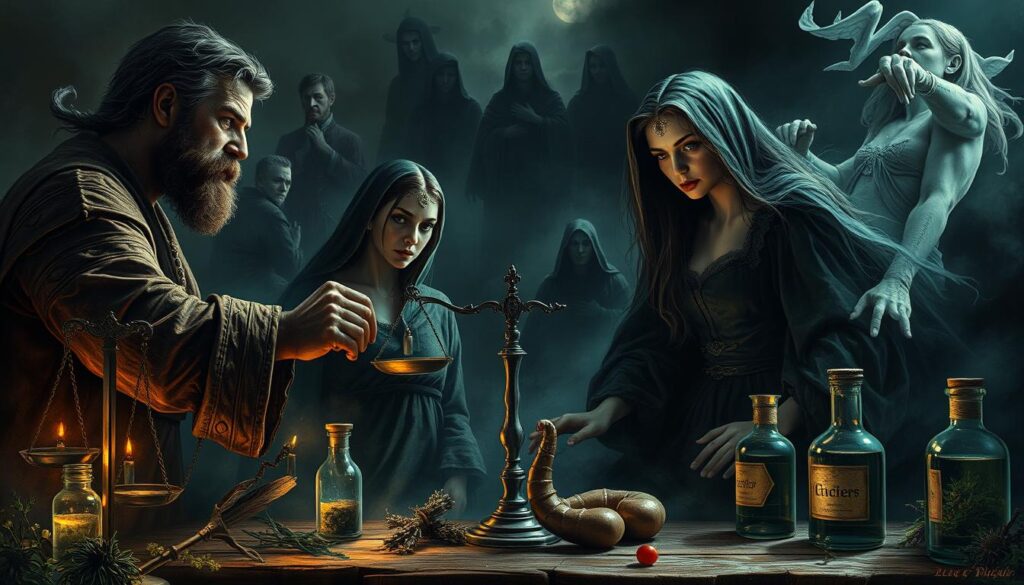
Persecution and Witch Hunts Today
Today, the persecution of those linked to witchcraft is still a sad fact. While witch hunts aren’t as big as they used to be, people, especially women, are still accused and face harsh punishments. This includes violence, being shunned, and even death.
In places like Ghana and Nepal, witchcraft is seen as a threat. So, witch hunts still happen. Women are often the main targets, accused of using magic for bad reasons.
These beliefs and the ongoing persecution show how deep and lasting the fear of witchcraft is in some areas. It’s a reminder of the stigma and fear that still surround witchcraft today.
- In 2005, polls in Canada and the UK showed that 13% of the population believed in witches, while in the US, 21% believed in witches.
- In Zambia, the World Health Organization (WHO) reported that nearly 25% of pregnant women are infected with HIV/AIDS, with some being accused of spreading it through witchcraft.
- In Papua New Guinea, several people have been killed due to accusations related to witchcraft, including a young girl burned alive for allegedly infecting men with HIV/AIDS.
- In Nigeria, children accused of witchcraft were burned, poisoned, and abused as recently as 2007, fueled by suspicions linked to rapid wealth accumulation.
These facts and stories show how common modern witch hunts and witchcraft persecution today still are. We need more education, awareness, and change to fight this issue.
“The persistence of these beliefs and the continued persecution of those associated with witchcraft highlight the deep-rooted and enduring nature of the stigma and fear surrounding the practice of witchcraft in certain parts of the world.”
Conclusion
The history of witches and witchcraft has always fascinated people for centuries. It started with ancient beliefs and ended with the witch trials of the past. Over time, how people saw and treated witches changed a lot.
Now, the witch hunts are less common, but their impact still affects some communities and people. The fear and stigma of witchcraft are still there, especially for those who are marginalized.
Looking into witchcraft’s history shows us the deep societal and cultural reasons behind it. It also shows the harm done to people and communities because of witch hunts. We see how important it is to understand and deal with the effects of these events.
We need to keep learning about witches’ history to truly appreciate its depth and lasting impact. By doing this, we can help create a better understanding of the past. This can lead to a future where witchcraft is no longer stigmatized.
FAQ
What is the history of witches?
Witchcraft has been fascinating and feared for centuries. It’s more than the image of an old woman on a broom or with black cats. Witches have left a mark on history, appearing in myths and stories from ancient times.
What are the origins of witchcraft?
Witchcraft goes back to ancient times. It’s seen in myths and stories from Roman and Celtic times. In Europe, it linked with the devil during the Middle Ages, thanks to Christianity.
How did the Reformation impact perceptions of witchcraft?
The Reformation in 1517 changed how people saw witches. Protestant leaders saw witchcraft as Satan’s work. This led to more fear and tension over supernatural beliefs.
What were the Salem Witch Trials?
The Salem witch trials were a dark chapter in history. In the late 1600s, Salem, Massachusetts, saw many accused and executed for witchcraft. It was a time of fear and hysteria.
How was witchcraft viewed in different cultures around the world?
Witchcraft wasn’t just a Western thing. It spread across Africa, Asia, the Pacific, South America, North America, and beyond. Each culture had its own way of practicing witchcraft, reflecting their unique traditions.
How did perceptions of witchcraft change over time?
As society evolved, so did views on witchcraft. The Renaissance questioned witchcraft accusations, seeking scientific explanations. Later, witchcraft became a part of popular culture, influencing art and entertainment.
What is the modern practice of Wicca?
In the 20th century, witchcraft made a comeback with Wicca and other movements. Wicca is a modern pagan belief that focuses on nature, rituals, and exploring magical powers.
How were gender and social status linked to witchcraft accusations?
Being different made you more likely to be accused of witchcraft. Poor, older, unmarried women, or those who argued with neighbors were often first accused. Most accused were women, showing deep gender and social biases.
Does the persecution of witches still occur today?
Yes, some places still see witchcraft as dangerous and hunt witches, often targeting women. While it’s not as widespread as before, witch hunts still happen, affecting many women.
